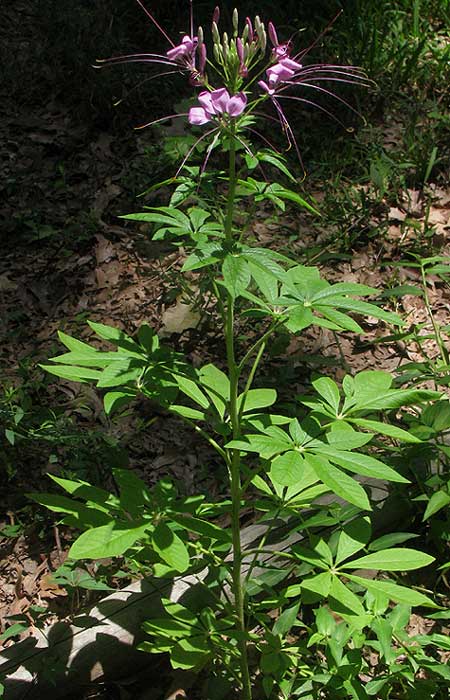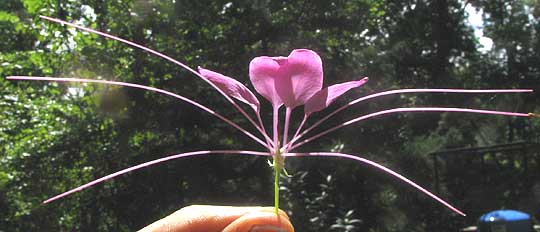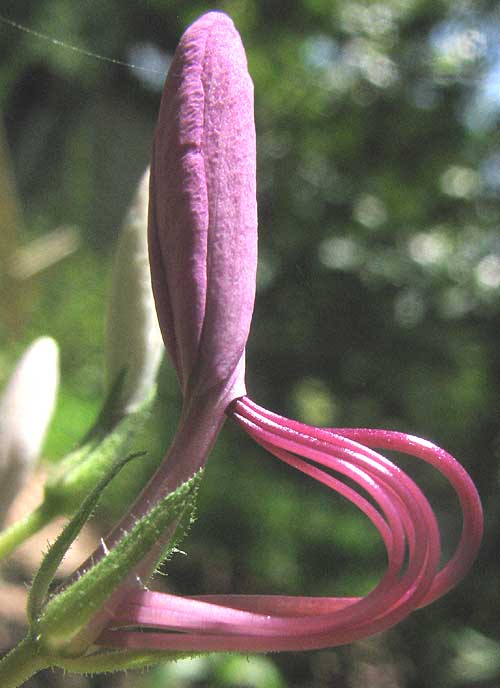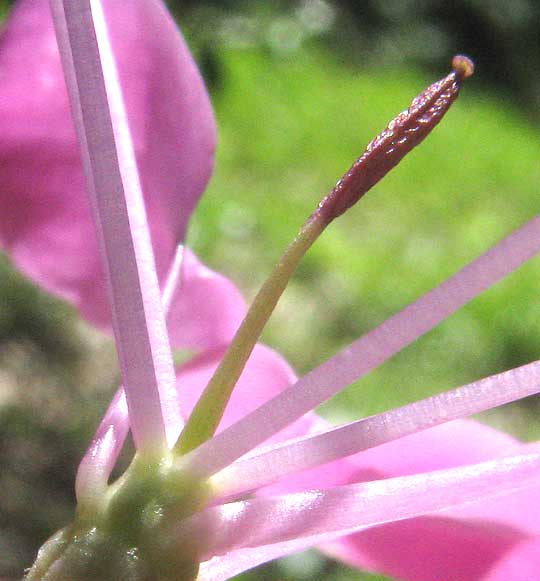Excerpts from Jim Conrad's
Naturalist Newsletter
from the July 29, 2012 Newsletter issued from the woods of the Loess Hill Region a few miles east of Natchez, Mississippi, USA
SPIDER FLOWER
When I arrived here in early April I found several packages of garden flower seeds, all three or four years old. Despite wondering whether the seeds would still be viable I sowed them in a garden spot. Only the four-o'clocks came up in profusion, plus a couple of knee-high plants of what's shown below:

One unusual feature of this plant is its "digitately compound" leaves -- leaves with their leaflet bases all united at one spot atop the leaf stem, or petiole. The compound leaves of most plants have their leaflets arising from a continuation of the petiole, the rachis. The flowers also are unusual, as shown below:

On this bilaterally symmetrical, or "zygomorphic," blossom you see only four petals held above six broadly spreading, pollen-producing stamens. Also, each blossom does something curious as it unfurls, as shown below:

As stamens emerge from the opening flower their anthers are protected as long as possible by wrapping them in the petals, which still are united into a cylinder. It's important to protect anthers because they produce pollen, the grains of which bear male sex germs. The female sex germs are even better protected in ovules inside the fleshy ovary nestled down inside the filaments' bases at the flower's bottom.
The most commonly used English name for this plant appears to be Spider Flower or Spider Plant, which are names used for many unrelated species. It' also called Spider Legs, Grandfather's Whiskers, Crown Flower, etc. Nowadays it's technically known as CLEOME HASSLERIANA, though in older publications it's listed as Cleome spinosa.
The plant family you think of normally producing flowers with four petals and six stamens in the Mustard Family. However, this garden plant is not a Mustard Family member. It's in the much smaller, mostly tropical and subtropical Caper Family, the Capparidaceae. In a close-up of our plant's flower interior you can see what separates our Spider Flower from all members of the Mustard Family below:

At the picture's top, right corner you see the dark purplish ovary -- the future fruit -- held far above the point where the flower's filaments and petals unite. The ovary stem, or "gynophore," is what distinguishes the Caper Family from the Mustard Family. Mustard-flower ovaries don't grow atop gynophores. Otherwise, the long, slender, many-seeded, capsular fruit looks just like a mustard-family fruit.
Spider flowers are tropical American plants that can be grown in summer gardens in many temperate countries. Several cultivars have been created. If you enjoy comparing technical features of flowers, you might like to compare the blossom of our present Cleome with one we found in a garden in southern Mexico of Gynandropsis speciosa -- a completely different genus -- at http://www.backyardnature.net/chiapas/cleome-7.jpg.
At first glance this Gynandropsis's flower structure looks identical to our Cleome's, but notice that the stamens' filaments unite on the gynophore well above the gynophore's base -- not at the base as in Cleome. That's enough to cast this group of flowers into an entirely different genus!